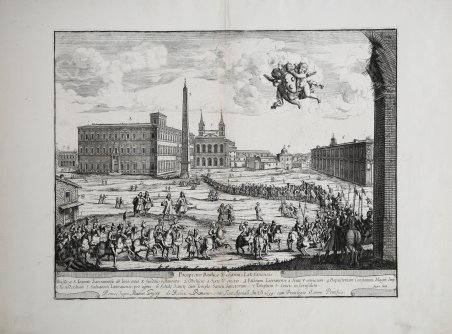Veduta di Piazza del Popolo incisa da Lievin Cruyl per l'editore Giovanni Battista de Rossi nel 1666. Esemplare nel secondo stato di tre, con l'indirizzo di ' Matteo Gregorio de Rossi e la data 1693. In questa edizione la stampa è completamente cambiata; sono abrasi i personaggi in primo piano e tutta la quinta del muro antico. Al loro posto è stata inserita una processione diretta verso il Laterano. In alto a destra sono aggiunti due puttini che sostengono lo stemma papale di Innocenzo XII Pignatelli; quasi a raccontare la cerimonia di Possesso del Papa, che si era insediato nel 1691. Cruyl inizia a disegnare ed incidere vedute nel momento in cui si trasferisce a Roma, intorno al 1664. Le prime opere furono i ventuno disegni, un tempo conservati all’Albertina di Vienna ed oggi divisi tra Cleveland Museum e Rijksmuseum. I disegni risultano, per finalità incisorie, in controparte rispetto ai luoghi rappresentati. Solo dieci di questi soggetti furono incisi dal Cruyl e pubblicati per la prima volta nel 1666 da Giovan Battista de Rossi in un volume dedicato a papa Alessandro VII, dal titolo ' Prospectus loco rum Urbis Romae Insignis, opera che in seguito fu ristampata da Matteo Gregorio de Rossi nel 1692/98. Cruyl caratterizza ogni sua veduta con l’inserimento di figure perfettamente aderenti al contesto urbano e, allo stesso tempo, descrive e definisce monumenti esistenti nella città di Papa Chigi. Per raggiungere il suo obbiettivo l’artista non esita ad alterare la realtà prospettica ne a modificare lo spazio urbano. Lievin Cruyl (1640-1720) disegnatore fiammingo di vedute prospettiche, originario di Gand, si trasferì a Roma nel 1644. Insieme a Giovan Battista Falda e a Israel Silvestre fu uno dei rinnovatori della veduta romana del XVII secolo. Seppure risentì della concezione cinquecentesca del ruolo dell’antico nell’immagine di Roma, rappresentò le novità architettoniche urbanistiche della Roma di Alessandro VII (Fabio Chigi 1655- 1667), caratterizzando le sue vedute con piccole scene di genere secondo la tradizione fiamminga. Nella rappresentazione dello spazio urbano Cruyl altera la prospettiva, alzando il punto di vista e dilatando il campo di visuale, utilizzando le più avanzate tecniche ottiche del tempo. ' Acquaforte, impressa su carta vergata coeva, con pieni margini, minimi restauri al verso della piega centrale verticale, per il resto in ottimo stato di conservazione. Bibliografia B. Jatta, ' Lievin Cruyl e la sua opera grafica, p. 155/4S, figg. 48-49. View of Piazza del Popolo engraved by Lievin Cruyl for publisher Giovanni Battista de Rossi in 1666. Example in the second state of three, with the address of Matteo Gregorio de Rossi and the date 1693. In this edition the print is completely changed; the figures in the foreground and the entire set of the ancient wall are abraded. In their place is inserted a procession heading toward the Lateran. Two cherubs supporting the papal coat of arms of Innocent XII Pignatelli are added at the top right; almost as if to tell of the ceremony of Possession of the Pope, who had settled in 1691. Cruyl starter drawing and engraving views when he moved to Rome around 1664. His first works were his twenty one drawings, once kept in the Albertina in Vienna and nowadays divided between the Cleveland Museum and Rijksmuseum. The drawings actually are the counterpart of the subjects they depict for they were meant to be used for the realization of engravings. Only ten of these subjects have actually been engraved by Cruyl and published for the first time in 1666 by Giovan Battista de Rossi in a volume dedicated to Pope Alexander VII, entitled ' Prospectus loco rum Urbis Romae Insignis; the collection was afterwards reissued by Matteo Gregorio de Rossi between 1692 and 1698. Cruyl characterized every single view by adding some figures which perfectly adhered to the urban context and, at the same time, he describes and defines the monuments of the city of Pope Alexander. To realized his aim, the artist changed the real perspective and modified the urban space. Lievin Cruyl (1640-1720) Flemish draughtsman of perspective views, originally from Ghent, moved to Rome in 1644. Together with Giovan Battista Falda and Israel Silvestre, he was one of the renewers of Roman views in the 17th century. Although he was influenced by the 16th century conception of the role of antiquity in the image of Rome, he represented the urban architectural innovations of the Rome of Alexander VII (Fabio Chigi 1655- 1667), characterising his views with small genre scenes in the Flemish tradition. In the representation of urban space, Cruyl alters perspective, raising the viewpoint and dilating the field of vision, using the most advanced optical techniques of the time. ' Etching, printed on contemporary laid paper, with full margins, minimal restorations to verso of vertical center fold, otherwise in excellent condition. Bibliografia B. Jatta, ' Lievin Cruyl e la sua opera grafica, p. 155/4S, figg. 48-49. Cfr.

Descubre cómo utilizar
Descubre cómo utilizar

